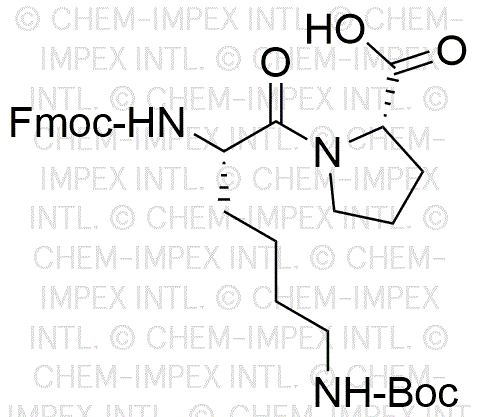Fmoc-Lys(Boc)-Pro-OH is widely utilized in research focused on:
- Peptide Synthesis: This compound serves as a key building block in the synthesis of peptides, particularly in solid-phase peptide synthesis (SPPS), allowing for the creation of complex peptide chains with high purity and yield.
- Drug Development: It plays a crucial role in the development of peptide-based therapeutics, enabling researchers to design and modify peptides that can target specific biological pathways, enhancing drug efficacy.
- Bioconjugation: The compound is used in bioconjugation processes, where it helps attach peptides to other biomolecules, such as antibodies or nanoparticles, facilitating targeted drug delivery systems.
- Protein Engineering: Researchers utilize this chemical to modify lysine residues in proteins, which can improve protein stability and functionality, making it valuable in biotechnology applications.
- Research in Cancer Therapies: Its application in developing peptide inhibitors or modulators has shown promise in cancer research, providing a pathway for creating novel treatments that can selectively target cancer cells.
General Information
Properties
Safety and Regulations
Applications
Fmoc-Lys(Boc)-Pro-OH is widely utilized in research focused on:
- Peptide Synthesis: This compound serves as a key building block in the synthesis of peptides, particularly in solid-phase peptide synthesis (SPPS), allowing for the creation of complex peptide chains with high purity and yield.
- Drug Development: It plays a crucial role in the development of peptide-based therapeutics, enabling researchers to design and modify peptides that can target specific biological pathways, enhancing drug efficacy.
- Bioconjugation: The compound is used in bioconjugation processes, where it helps attach peptides to other biomolecules, such as antibodies or nanoparticles, facilitating targeted drug delivery systems.
- Protein Engineering: Researchers utilize this chemical to modify lysine residues in proteins, which can improve protein stability and functionality, making it valuable in biotechnology applications.
- Research in Cancer Therapies: Its application in developing peptide inhibitors or modulators has shown promise in cancer research, providing a pathway for creating novel treatments that can selectively target cancer cells.
Documents
Safety Data Sheets (SDS)
The SDS provides comprehensive safety information on handling, storage, and disposal of the product.
Product Specification (PS)
The PS provides a comprehensive breakdown of the product’s properties, including chemical composition, physical state, purity, and storage requirements. It also details acceptable quality ranges and the product's intended applications.
Certificates of Analysis (COA)
Search for Certificates of Analysis (COA) by entering the products Lot Number. Lot and Batch Numbers can be found on a product’s label following the words ‘Lot’ or ‘Batch’.
Número de catálogo
Número de lote/lote
Certificates Of Origin (COO)
This COO confirms the country where the product was manufactured, and also details the materials and components used in it and whether it is derived from natural, synthetic, or other specific sources. This certificate may be required for customs, trade, and regulatory compliance.
Número de catálogo
Número de lote/lote
Safety Data Sheets (SDS)
The SDS provides comprehensive safety information on handling, storage, and disposal of the product.
DownloadProduct Specification (PS)
The PS provides a comprehensive breakdown of the product’s properties, including chemical composition, physical state, purity, and storage requirements. It also details acceptable quality ranges and the product's intended applications.
DownloadCertificates of Analysis (COA)
Search for Certificates of Analysis (COA) by entering the products Lot Number. Lot and Batch Numbers can be found on a product’s label following the words ‘Lot’ or ‘Batch’.
Número de catálogo
Número de lote/lote
Certificates Of Origin (COO)
This COO confirms the country where the product was manufactured, and also details the materials and components used in it and whether it is derived from natural, synthetic, or other specific sources. This certificate may be required for customs, trade, and regulatory compliance.


